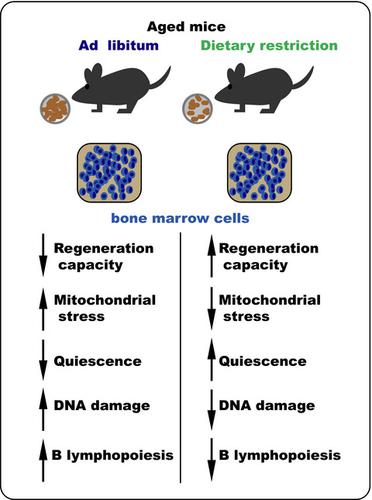当前位置:
X-MOL 学术
›
Aging Cell
›
论文详情
Our official English website, www.x-mol.net, welcomes your feedback! (Note: you will need to create a separate account there.)
Long-term mid-onset dietary restriction rejuvenates hematopoietic stem cells and improves regeneration capacity of total bone marrow from aged mice.
Aging Cell ( IF 7.8 ) Pub Date : 2020-09-15 , DOI: 10.1111/acel.13241 Si Tao 1, 2 , Yiting Wang 3 , Jianying Wu 1, 2 , Ting Zeng 1, 2 , Hui Cui 1, 2 , Zhendong Tao 4 , Lang Lei 5 , Li Yu 3 , Anwen Liu 1, 2 , Hua Wang 1, 2 , Liu Zhang 6 , Duozhuang Tang 3
Aging Cell ( IF 7.8 ) Pub Date : 2020-09-15 , DOI: 10.1111/acel.13241 Si Tao 1, 2 , Yiting Wang 3 , Jianying Wu 1, 2 , Ting Zeng 1, 2 , Hui Cui 1, 2 , Zhendong Tao 4 , Lang Lei 5 , Li Yu 3 , Anwen Liu 1, 2 , Hua Wang 1, 2 , Liu Zhang 6 , Duozhuang Tang 3
Affiliation

|
Currently, the world's aging population is expanding rapidly, leading to a rise in aged hematopoietic cell transplantation (HCT) recipients and aged donors. However, the age of donors is negatively related to the prognosis after transplantation due to functional decline in hematopoietic stem cells (HSCs) during aging. Previously, we showed that an early‐onset dietary restriction (DR) significantly retards early aging of HSCs. However, the effects of a mid‐onset DR on HSCs remain unknown. In the current study, we performed 30% DR in 15‐ to 18‐month‐old mice (equivalent to 50–60 human years) for short‐term (4 months) and long‐term (9 months). We show that DR reduces and rectifies the imbalance of the HSC pool in aged mice. Short‐term DR improves hematopoietic reconstitution in purified HSC transplantations, but not in bone marrow transplantations. Intriguingly, long‐term mid‐onset DR improves the hematopoietic regeneration of aging HSCs with a particular enhancement of lymphoid outputs even in total bone marrow transplantation settings. Mechanistically, long‐term DR rejuvenates the aberrantly regulated mitochondrial pathways in aging HSCs and is accompanied by increased quiescence and reduced DNA damage signaling in HSCs. Short‐term DR showed a similar trend of rescuing these aging hallmarks but to a much lesser extent. Together, the current study suggests that mid‐onset DR ameliorates the function of aging HSCs and long‐term DR even improved hematopoietic reconstitution in bone marrow transplantation, which could potentially have considerable implications in HCT of humans when only old donors are available.
中文翻译:

长期中期饮食限制可使造血干细胞恢复活力,并提高老年小鼠总骨髓的再生能力。
当前,世界人口老龄化迅速扩大,导致老年造血细胞移植(HCT)受者和老年捐献者增多。然而,由于衰老过程中造血干细胞(HSC)的功能下降,供体的年龄与移植后的预后呈负相关。以前,我们表明早发性饮食限制(DR)显着延缓 HSC 的早期衰老。然而,中期 DR 对 HSC 的影响仍然未知。在目前的研究中,我们对 15 至 18 个月大的小鼠(相当于 50 至 60 岁)进行了短期(4 个月)和长期(9 个月)的 30% DR。我们表明 DR 减少并纠正了老年小鼠 HSC 池的不平衡。短期 DR 可改善纯化 HSC 移植中的造血重建,但不是在骨髓移植中。有趣的是,即使在全骨髓移植环境中,长期中期 DR 也能改善衰老 HSC 的造血再生,并特别增强淋巴输出。从机制上讲,长期 DR 使衰老 HSC 中异常调节的线粒体途径恢复活力,并伴随着 HSC 中静止状态的增加和 DNA 损伤信号的减少。短期 DR 显示出类似的趋势,可以挽救这些衰老特征,但程度要小得多。总之,目前的研究表明,中期 DR 改善了衰老 HSC 的功能,长期 DR 甚至改善了骨髓移植中的造血重建,当只有老年供体可用时,这可能对人类的 HCT 产生相当大的影响。长期中期 DR 可改善衰老 HSC 的造血再生,甚至在全骨髓移植环境中也能特别增强淋巴输出。从机制上讲,长期 DR 使衰老 HSC 中异常调节的线粒体途径恢复活力,并伴随着 HSC 中静止状态的增加和 DNA 损伤信号的减少。短期 DR 显示出类似的趋势,可以挽救这些衰老特征,但程度要小得多。总之,目前的研究表明,中期 DR 改善了衰老 HSC 的功能,长期 DR 甚至改善了骨髓移植中的造血重建,当只有老年供体可用时,这可能对人类的 HCT 产生相当大的影响。长期中期 DR 可改善衰老 HSC 的造血再生,甚至在全骨髓移植环境中也能特别增强淋巴输出。从机制上讲,长期 DR 使衰老 HSC 中异常调节的线粒体途径恢复活力,并伴随着 HSC 中静止状态的增加和 DNA 损伤信号的减少。短期 DR 显示出类似的趋势,可以挽救这些衰老特征,但程度要小得多。总之,目前的研究表明,中期 DR 改善了衰老 HSC 的功能,长期 DR 甚至改善了骨髓移植中的造血重建,当只有老年供体可用时,这可能对人类的 HCT 产生相当大的影响。
更新日期:2020-10-23
中文翻译:

长期中期饮食限制可使造血干细胞恢复活力,并提高老年小鼠总骨髓的再生能力。
当前,世界人口老龄化迅速扩大,导致老年造血细胞移植(HCT)受者和老年捐献者增多。然而,由于衰老过程中造血干细胞(HSC)的功能下降,供体的年龄与移植后的预后呈负相关。以前,我们表明早发性饮食限制(DR)显着延缓 HSC 的早期衰老。然而,中期 DR 对 HSC 的影响仍然未知。在目前的研究中,我们对 15 至 18 个月大的小鼠(相当于 50 至 60 岁)进行了短期(4 个月)和长期(9 个月)的 30% DR。我们表明 DR 减少并纠正了老年小鼠 HSC 池的不平衡。短期 DR 可改善纯化 HSC 移植中的造血重建,但不是在骨髓移植中。有趣的是,即使在全骨髓移植环境中,长期中期 DR 也能改善衰老 HSC 的造血再生,并特别增强淋巴输出。从机制上讲,长期 DR 使衰老 HSC 中异常调节的线粒体途径恢复活力,并伴随着 HSC 中静止状态的增加和 DNA 损伤信号的减少。短期 DR 显示出类似的趋势,可以挽救这些衰老特征,但程度要小得多。总之,目前的研究表明,中期 DR 改善了衰老 HSC 的功能,长期 DR 甚至改善了骨髓移植中的造血重建,当只有老年供体可用时,这可能对人类的 HCT 产生相当大的影响。长期中期 DR 可改善衰老 HSC 的造血再生,甚至在全骨髓移植环境中也能特别增强淋巴输出。从机制上讲,长期 DR 使衰老 HSC 中异常调节的线粒体途径恢复活力,并伴随着 HSC 中静止状态的增加和 DNA 损伤信号的减少。短期 DR 显示出类似的趋势,可以挽救这些衰老特征,但程度要小得多。总之,目前的研究表明,中期 DR 改善了衰老 HSC 的功能,长期 DR 甚至改善了骨髓移植中的造血重建,当只有老年供体可用时,这可能对人类的 HCT 产生相当大的影响。长期中期 DR 可改善衰老 HSC 的造血再生,甚至在全骨髓移植环境中也能特别增强淋巴输出。从机制上讲,长期 DR 使衰老 HSC 中异常调节的线粒体途径恢复活力,并伴随着 HSC 中静止状态的增加和 DNA 损伤信号的减少。短期 DR 显示出类似的趋势,可以挽救这些衰老特征,但程度要小得多。总之,目前的研究表明,中期 DR 改善了衰老 HSC 的功能,长期 DR 甚至改善了骨髓移植中的造血重建,当只有老年供体可用时,这可能对人类的 HCT 产生相当大的影响。



























 京公网安备 11010802027423号
京公网安备 11010802027423号